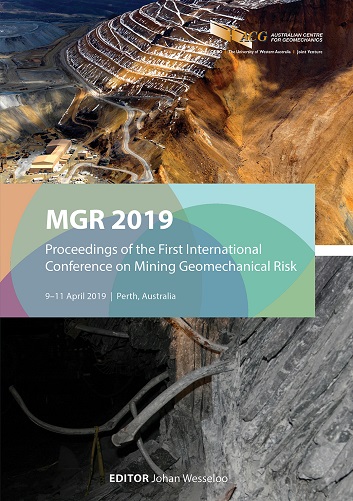Combining expert opinion and instrumentation data using Bayesian networks to carry out stope collapse risk assessment

|
Authors: Mishra, R; Kiuru, R; Uotinen, L; Janiszewski, M; Rinne, M |
DOI https://doi.org/10.36487/ACG_rep/1905_02_Mishra
Cite As:
Mishra, R, Kiuru, R, Uotinen, L, Janiszewski, M & Rinne, M 2019, 'Combining expert opinion and instrumentation data using Bayesian networks to carry out stope collapse risk assessment', in J Wesseloo (ed.), MGR 2019: Proceedings of the First International Conference on Mining Geomechanical Risk, Australian Centre for Geomechanics, Perth, pp. 85-96, https://doi.org/10.36487/ACG_rep/1905_02_Mishra
Abstract:
Stope collapse is a common form of accident resulting in property loss and bodily harm in mines. There are several methods to carry out risk assessment for stope collapse incident in an underground mine. This paper presents an alternate method to determine stope collapse probability using Bayesian belief networks. The alternate methodology is designed to replace a subjective risk assessment process in a metal mine in Finland. First, the stope collapse failure mechanism specific to the underground mine was established by carrying out interviews with stake holders in the underground mine. These failure modes have been mapped using Bayesian network with the use of expert opinion. The expert opinions were obtained from the interviews and their correlation and interdependencies have been defined. Use of continuous data obtained from site instrumentation in the Bayesian network has been discussed to validate the expert opinion model and to create a near real-time risk monitoring system. Updating of failure probabilities using new evidence has been discussed using a ‘what-if’ scenario analysis and use of backward inference to carry out incident investigation in the event of a failure has been described. The paper further elaborates on how Bayesian modelling for risk assessment can be incorporated in mining to justify mitigation measures and use this as a decision-making tool. When combined with existing data collection systems in the mine, this can form the backbone for a real-time risk management system.
Keywords: Bayesian network, expert opinion, interview, stope design, mitigation
References:
Bayes, M & Price, M 1763, ‘An essay towards solving a problem in the doctrine of chances. By the late Rev. Mr. Bayes, F.R.S. communicated by Mr. Price, in a letter to John Canton, A.M.F.R.S’, Philosophical Transactions, vol. 53, pp. 370–418,
Blumenstein, D, Ferreiter, R, Powers, J & Reiher, M 2011, Accidents - The Total Cost. A Guide for Estimating the Total Cost of Accidents, Colorado School of Mines, Golden, viewed 2 October 2018,
Fenton, N & Neil, M 2012, Risk Assessment and Decision Analysis with Bayesian Networks, CRC Press, Boca Raton.
Hoek, E 1994, ‘Strength of rock and rock masses’, ISRM News Journal, vol. 2, no. 2, pp. 4–16.
ISO 2009, ISO 31000:2009 Risk Management – Principles and Guidelines, International Organization for Standardization, Geneva,
Marinos, V, Marinos, P & Hoek, E 2005, ‘The geological strength index: applications and limitations’, Bulletin of Engineering Geology and the Environment, vol. 64, no. 1, pp. 55–65,
Mishra, RK, Janiszewski, M, Uotinen, LKT, Szydlowska, M, Siren, T & Rinne, M 2017, ‘Geotechnical risk management concept for intelligent deep mines’, Procedia Engineering, vol. 191, pp. 361–368,
Spiegelhalter, DJ & Lauritzen, SL 1990, ‘Sequential updating of conditional probabilities on directed graphical structures’, Networks, vol. 20, no. 5, pp. 579–605.
© Copyright 2025, Australian Centre for Geomechanics (ACG), The University of Western Australia. All rights reserved.
View copyright/legal information
Please direct any queries or error reports to repository-acg@uwa.edu.au
View copyright/legal information
Please direct any queries or error reports to repository-acg@uwa.edu.au
